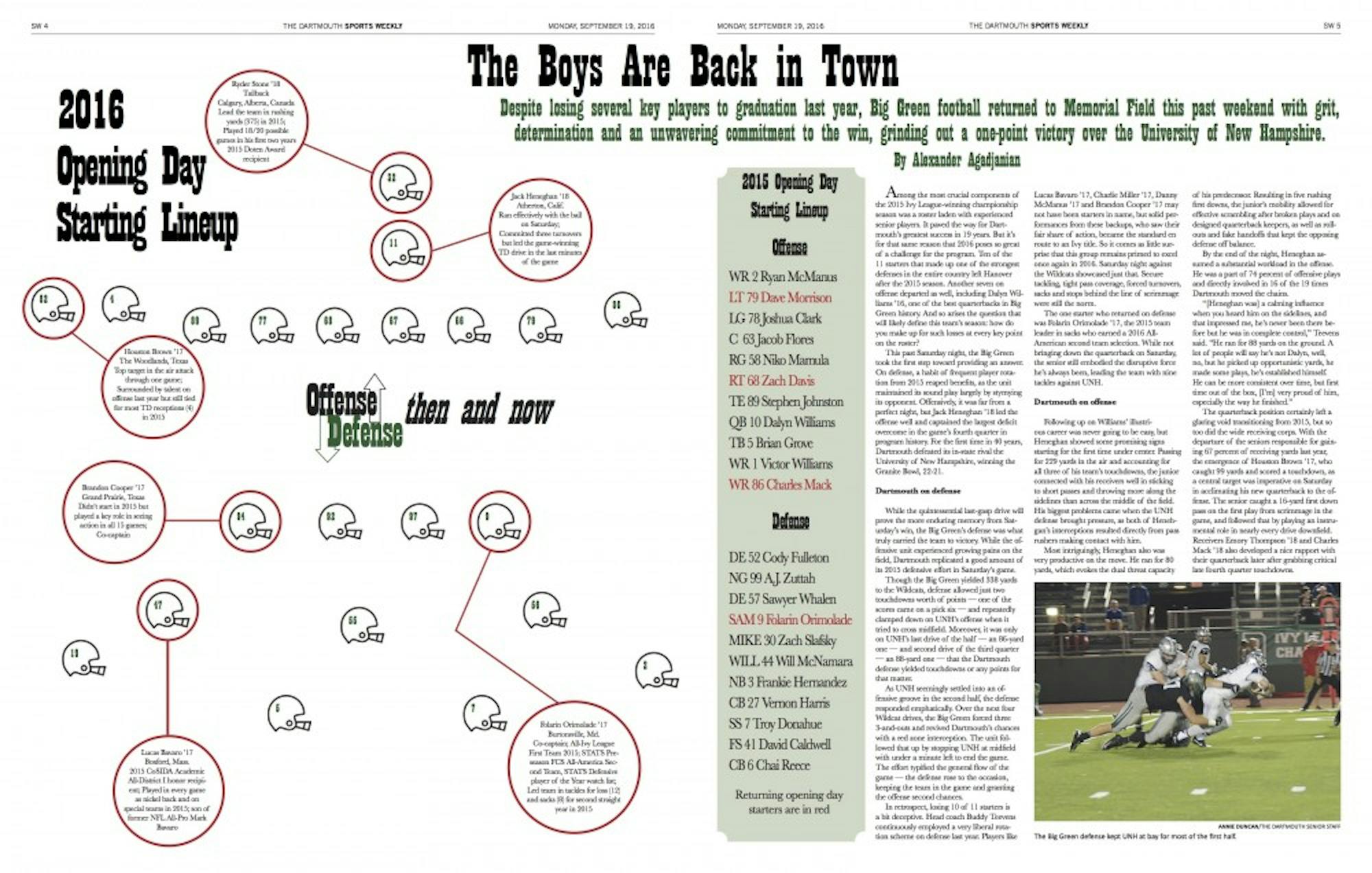Among the most crucial components of the 2015 Ivy League-winning championship season was a roster laden with experienced senior players. It paved the way for Dartmouth’s greatest success in 19 years. But it’s for that same reason that 2016 poses so great of a challenge for the program. Ten of the 11 starters that made up one of the strongest defenses in the entire country left Hanover after the 2015 season. Another seven on offense departed as well, including Dalyn Williams ’16, one of the best quarterbacks in Big Green history. And so arises the question that will likely define this team’s season: how do you make up for such losses at every key point on the roster?
This past Saturday night, the Big Green took the first step toward providing an answer. On defense, a habit of frequent player rotation from 2015 reaped benefits, as the unit maintained its sound play largely by stymying its opponent. Offensively, it was far from a perfect night, but Jack Heneghan ’18 led the offense well and captained the largest deficit overcome in the game’s fourth quarter in program history. For the first time in 40 years, Dartmouth defeated its in-state rival the University of New Hampshire, winning the Granite Bowl, 22-21.
Dartmouth on defense
While the quintessential last-gasp drive will prove the more enduring memory from Saturday’s win, the Big Green’s defense was what truly carried the team to victory. While the offensive unit experienced growing pains on the field, Dartmouth replicated a good amount of its 2015 defensive effort in Saturday’s game.
Though the Big Green yielded 338 yards to the Wildcats, defense allowed just two touchdowns worth of points — one of the scores came on a pick six — and repeatedly clamped down on UNH’s offense when it tried to cross midfield. Moreover, it was only on UNH’s last drive of the half — an 86-yard one — and second drive of the third quarter — an 88-yard one — that the Dartmouth defense yielded touchdowns or any points for that matter.
As UNH seemingly settled into an offensive groove in the second half, the defense responded emphatically. Over the next four Wildcat drives, the Big Green forced three 3-and-outs and revived Dartmouth’s chances with a red zone interception. The unit followed that up by stopping UNH at midfield with under a minute left to end the game. The effort typified the general flow of the game — the defense rose to the occasion, keeping the team in the game and granting the offense second chances.
In retrospect, losing 10 of 11 starters is a bit deceptive. Head coach Buddy Teevens continuously employed a very liberal rotation scheme on defense last year. Players like Lucas Bavaro ’17, Charlie Miller ’17, Danny McManus ’17 and Brandon Cooper ’17 may not have been starters in name, but solid performances from these backups, who saw their fair share of action, became the standard en route to an Ivy title. So it comes as little surprise that this group remains primed to excel once again in 2016. Saturday night against the Wildcats showcased just that. Secure tackling, tight pass coverage, forced turnovers, sacks and stops behind the line of scrimmage were still the norm.
The one starter who returned on defense was Folarin Orimolade ’17, the 2015 team leader in sacks who earned a 2016 All-American second team selection. While not bringing down the quarterback on Saturday, the senior still embodied the disruptive force he’s always been, leading the team with nine tackles against UNH.
Dartmouth on offense
Following up on Williams’ illustrious career was never going to be easy, but Heneghan showed some promising signs starting for the first time under center. Passing for 229 yards in the air and accounting for all three of his team’s touchdowns, the junior connected with his receivers well in sticking to short passes and throwing more along the sidelines than across the middle of the field. His biggest problems came when the UNH defense brought pressure, as both of Henehgan’s interceptions resulted directly from pass rushers making contact with him.
Most intriguingly, Heneghan also was very productive on the move. He ran for 80 yards, which evokes the dual threat capacity of his predecessor. Resulting in five rushing first downs, the junior’s mobility allowed for effective scrambling after broken plays and on designed quarterback keepers, as well as rollouts and fake handoffs that kept the opposing defense off balance.
By the end of the night, Heneghan assumed a substantial workload in the offense. He was a part of 74 percent of offensive plays and directly involved in 16 of the 19 times Dartmouth moved the chains.
“[Heneghan was] a calming influence when you heard him on the sidelines, and that impressed me, he’s never been there before but he was in complete control,” Teevens said. “He ran for 88 yards on the ground. A lot of people will say he’s not Dalyn, well, no, but he picked up opportunistic yards, he made some plays, he’s established himself. He can be more consistent over time, but first time out of the box, [I’m] very proud of him, especially the way he finished.”
The quarterback position certainly left a glaring void transitioning from 2015, but so too did the wide receiving corps. With the departure of the seniors responsible for gaining 67 percent of receiving yards last year, the emergence of Houston Brown ’17, who caught 99 yards and scored a touchdown, as a central target was imperative on Saturday in acclimating his new quarterback to the offense. The senior caught a 16-yard first down pass on the first play from scrimmage in the game, and followed that by playing an instrumental role in nearly every drive downfield. Receivers Emory Thompson ’18 and Charles Mack ’18 also developed a nice rapport with their quarterback later after grabbing critical late fourth quarter touchdowns.




